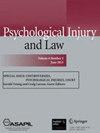Cross-Validating the Atypical Response Scale of the TSI-2 in a Sample of Motor Vehicle Collision Survivors
IF 2.7
Q2 PSYCHOLOGY, CLINICAL
引用次数: 0
Abstract
Abstract This study was designed to evaluate the utility of the Atypical Responses (ATR) scale of the Trauma Symptom Inventory – Second Edition (TSI-2) as a symptom validity test (SVT) in a medicolegal sample. Archival data were collected from a consecutive case sequence of 99 patients referred for neuropsychological evaluation following a motor vehicle collision. The ATR’s classification accuracy was computed against criterion measures consisting of composite indices based on SVTs and performance validity tests (PVTs). An ATR cutoff of ≥ 9 emerged as the optimal cutoff, producing a good combination of sensitivity (.35-.53) and specificity (.92-.95) to the criterion SVT, correctly classifying 71–79% of the sample. Predictably, classification accuracy was lower against PVTs as criterion measures (.26-.37 sensitivity at .90-.93 specificity, correctly classifying 66–69% of the sample). The originally proposed ATR cutoff (≥ 15) was prohibitively conservative, resulting in a 90–95% false negative rate. In contrast, although the more liberal alternative (≥ 8) fell short of the specificity standard (.89), it was associated with notably higher sensitivity (.43-.68) and the highest overall classification accuracy (71–82% of the sample). Non-credible symptom report was a stronger confound on the posttraumatic stress scale of the TSI-2 than that of the Personality Assessment Inventory. The ATR demonstrated its clinical utility in identifying non-credible symptom report (and to a lesser extent, invalid performance) in a medicolegal setting, with ≥ 9 emerging as the optimal cutoff. The ATR demonstrated its potential to serve as a quick (potentially stand-alone) screener for the overall credibility of neuropsychological deficits. More research is needed in patients with different clinical characteristics assessed in different settings to establish the generalizability of the findings.机动车碰撞幸存者TSI-2非典型反应量表的交叉验证
摘要本研究旨在评估创伤症状量表第二版(TSI-2)的非典型反应(ATR)量表作为症状效度测试(SVT)在医学法律样本中的效用。档案资料收集自99例机动车碰撞后进行神经心理学评估的连续病例序列。根据基于svt和性能效度测试(pvt)的复合指标组成的标准度量来计算ATR的分类精度。ATR截断值≥9被认为是最佳截断值,对标准SVT产生良好的敏感性(0.35 - 0.53)和特异性(0.92 - 0.95),正确分类71-79%的样本。可以预见的是,相对于pvt作为标准度量,分类准确率较低(.26-)。37灵敏度为。90-。93特异性,正确分类66-69%的样本)。最初提出的ATR截止值(≥15)过于保守,导致90-95%的假阴性率。相比之下,虽然更自由的选择(≥8)达不到特异性标准(0.89),但它与更高的灵敏度(0.43 - 0.68)和最高的总体分类准确率(71-82%的样本)相关。不可信症状报告在创伤后应激量表上比在人格评估量表上更容易混淆。在医学法律环境中,ATR在识别不可信的症状报告(以及较小程度上的无效表现)方面证明了其临床实用性,最佳临界值≥9。ATR证明了它作为一种快速(潜在的独立)筛选神经心理缺陷整体可信度的潜力。需要对具有不同临床特征的患者进行更多的研究,在不同的环境中进行评估,以确定研究结果的普遍性。
本文章由计算机程序翻译,如有差异,请以英文原文为准。
求助全文
约1分钟内获得全文
求助全文
来源期刊

Psychological Injury & Law
PSYCHOLOGY, CLINICAL-
CiteScore
5.70
自引率
25.80%
发文量
29
期刊介绍:
Psychological Injury and Law is a journal designed as a multidisciplinary forum for the dissemination of research articles and scholarly exchanges about issues pertaining to the interface of psychology and law in the area of trauma, injury, and their psychological impact. The journal intends to help build the evidentiary research base of the field, and to critically examine its concepts and practice. Psychological impairments and disabilities may arise from physical and/or mental injuries ascribed to alleged negligent actions. They need to be judiciously assessed for their validity, and treated when evaluated as valid. They lead to legal and related action when there are long term or permanent effects.
 求助内容:
求助内容: 应助结果提醒方式:
应助结果提醒方式:


